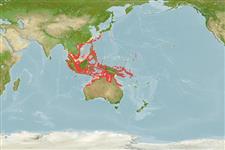Teleostei (teleosts) >
Eupercaria/misc (Various families in series Eupercaria) >
Nemipteridae (Threadfin breams, Whiptail breams)
Etymology: Scolopsis: Name from the Greek masculine noun 'skolos' meaning 'thorn' and suffix '-opsis' (from Greek feminine n. 'opsis' meaning 'aspect', 'appearance') meaning ‘thorny appearance’ presumably referring to 'les dentelures de la préopercule, en ont aussi, et même d'épineuses, aux sous-orbitaires' mentioned by Cuvier (1814) in his designation of the genus. Name ending in -'opsis' are treated as feminine according to ICZN 1999: Article 30.1.2 (Ref. 130620).
More on author: Peters.
Environment: milieu / climate zone / depth range / distribution range
Ecology
Marine; reef-associated; depth range 3 - 60 m (Ref. 37816). Tropical; 32°N - 21°S, 96°E - 166°E (Ref. 3810)
Western Pacific: Andaman Sea in the eastern Indian Ocean to Indonesia, north to the Ryukyu Islands, south to northeastern Australia and the Solomon Islands. This species has been incorrectly referred to as Scolopsis personatus (a junior synonym of Scolopsis auratus) by some authors.
Size / Weight / Age
Maturity: Lm ? range ? - ? cm
Max length : 24.0 cm TL male/unsexed; (Ref. 9710); common length : 15.0 cm SL male/unsexed; (Ref. 3810)
Dorsal spines (total): 10; Dorsal soft rays (total): 9; Anal spines: 3; Anal soft rays: 7. Lower limb of preopercle scaly. Antrorse (forward-directed) suborbital spine absent. Pelvic fins long, reaching to or beyond level of anus. Larger specimens with upper and lower lobes falcate. Presence of indistinct bluish stripe between eyes and a narrow white stripe from middle of upper lip to below eye. Juveniles with dusky brown stripe on either side of dorsal midline, and dusky brown midlateral stripe, yellowish above anteriorly. Axillary scale present. Color: Body silvery-white. Top of head and snout dusky grey. An indistinct bluish stripe between eyes. A narrow white stripe from middle of upper lip to below eye.
Inhabits sheltered lagoons on sandy or muddy bottoms close to reefs. Occurs singly or in small aggregations. Adults mainly in depths over 15 m; juveniles solitary and in sheltered coastal habitats (Ref. 48635).
Life cycle and mating behavior
Maturity | Reproduction | Spawning | Eggs | Fecundity | Larvae
Russell, B.C., 1990. FAO Species Catalogue. Vol. 12. Nemipterid fishes of the world. (Threadfin breams, whiptail breams, monocle breams, dwarf monocle breams, and coral breams). Family Nemipteridae. An annotated and illustrated catalogue of nemipterid species known to date. FAO Fish. Synop. 125(12):149p. Rome: FAO. (Ref. 3810)
IUCN Red List Status (Ref. 130435: Version 2024-1)
Threat to humans
Harmless
Human uses
Fisheries: subsistence fisheries
Tools
Special reports
Download XML
Internet sources
Estimates based on models
Preferred temperature (Ref.
123201): 25.3 - 29.1, mean 28.3 °C (based on 1082 cells).
Phylogenetic diversity index (Ref.
82804): PD
50 = 0.5000 [Uniqueness, from 0.5 = low to 2.0 = high].
Bayesian length-weight: a=0.01660 (0.00747 - 0.03689), b=2.98 (2.81 - 3.15), in cm total length, based on LWR estimates for this Genus-body shape (Ref.
93245).
Trophic level (Ref.
69278): 3.3 ±0.39 se; based on food items.
Resilience (Ref.
120179): High, minimum population doubling time less than 15 months (Preliminary K or Fecundity.).
Fishing Vulnerability (Ref.
59153): Low vulnerability (14 of 100).
Nutrients (Ref.
124155): Calcium = 64.7 [38.5, 128.3] mg/100g; Iron = 0.703 [0.347, 1.629] mg/100g; Protein = 18.9 [17.0, 20.6] %; Omega3 = 0.155 [0.093, 0.261] g/100g; Selenium = 31.2 [19.1, 55.5] μg/100g; VitaminA = 73.9 [21.0, 213.8] μg/100g; Zinc = 1.37 [0.95, 2.00] mg/100g (wet weight);
